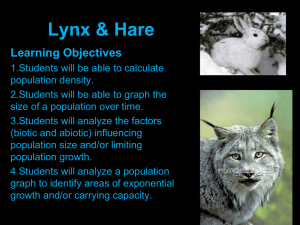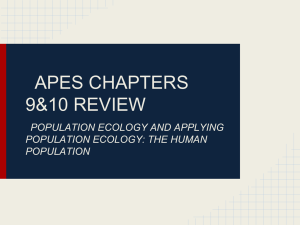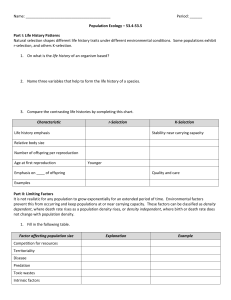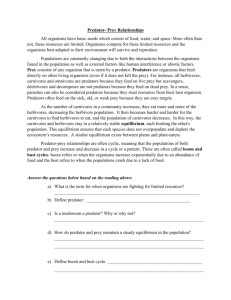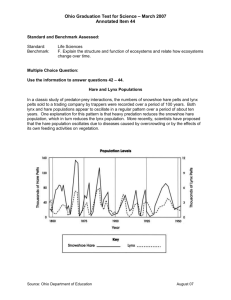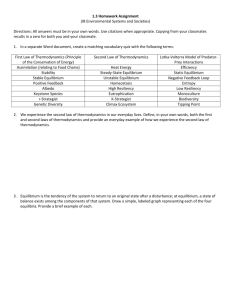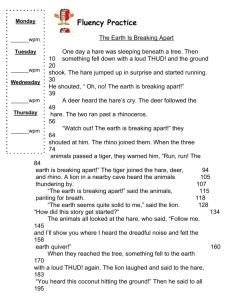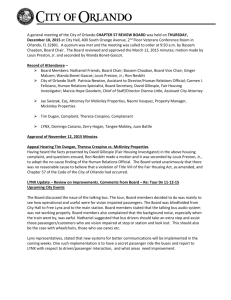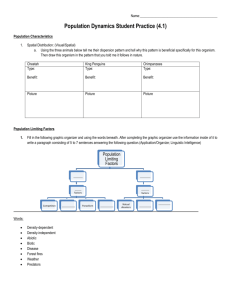Zoology PracticalEdited20Aug
advertisement
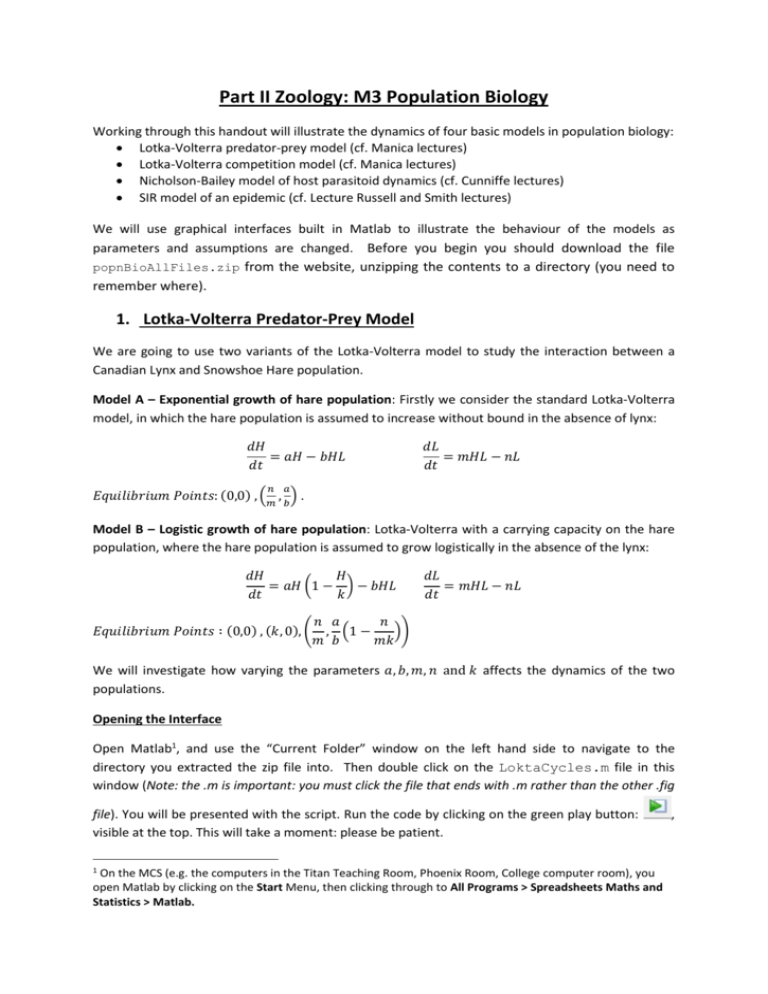
Part II Zoology: M3 Population Biology Working through this handout will illustrate the dynamics of four basic models in population biology: Lotka-Volterra predator-prey model (cf. Manica lectures) Lotka-Volterra competition model (cf. Manica lectures) Nicholson-Bailey model of host parasitoid dynamics (cf. Cunniffe lectures) SIR model of an epidemic (cf. Lecture Russell and Smith lectures) We will use graphical interfaces built in Matlab to illustrate the behaviour of the models as parameters and assumptions are changed. Before you begin you should download the file popnBioAllFiles.zip from the website, unzipping the contents to a directory (you need to remember where). 1. Lotka-Volterra Predator-Prey Model We are going to use two variants of the Lotka-Volterra model to study the interaction between a Canadian Lynx and Snowshoe Hare population. Model A – Exponential growth of hare population: Firstly we consider the standard Lotka-Volterra model, in which the hare population is assumed to increase without bound in the absence of lynx: 𝑑𝐻 = 𝑎𝐻 − 𝑏𝐻𝐿 𝑑𝑡 𝑑𝐿 = 𝑚𝐻𝐿 − 𝑛𝐿 𝑑𝑡 𝑛 𝑎 𝑚 𝑏 𝐸𝑞𝑢𝑖𝑙𝑖𝑏𝑟𝑖𝑢𝑚 𝑃𝑜𝑖𝑛𝑡𝑠: (0,0) , ( , ) . Model B – Logistic growth of hare population: Lotka-Volterra with a carrying capacity on the hare population, where the hare population is assumed to grow logistically in the absence of the lynx: 𝑑𝐻 𝐻 = 𝑎𝐻 (1 − ) − 𝑏𝐻𝐿 𝑑𝑡 𝑘 𝐸𝑞𝑢𝑖𝑙𝑖𝑏𝑟𝑖𝑢𝑚 𝑃𝑜𝑖𝑛𝑡𝑠 ∶ (0,0) , (𝑘, 0), ( 𝑑𝐿 = 𝑚𝐻𝐿 − 𝑛𝐿 𝑑𝑡 𝑛 𝑎 𝑛 , (1 − )) 𝑚 𝑏 𝑚𝑘 We will investigate how varying the parameters 𝑎, 𝑏, 𝑚, 𝑛 and 𝑘 affects the dynamics of the two populations. Opening the Interface Open Matlab1, and use the “Current Folder” window on the left hand side to navigate to the directory you extracted the zip file into. Then double click on the LoktaCycles.m file in this window (Note: the .m is important: you must click the file that ends with .m rather than the other .fig file). You will be presented with the script. Run the code by clicking on the green play button: visible at the top. This will take a moment: please be patient. 1 On the MCS (e.g. the computers in the Titan Teaching Room, Phoenix Room, College computer room), you open Matlab by clicking on the Start Menu, then clicking through to All Programs > Spreadsheets Maths and Statistics > Matlab. , The interface opens with model A, as fitted to data collected from the Hudson Bay company2, with initial hare and lynx populations 35,000 and 3,900, respectively. The parameters default to these values: 𝑎 = 0.48, 𝑏 = 0.025, 𝑛 = 0.93 , 𝑚 = 0.025. Note the concordance between the model prediction and the empirical results. Model A Ensure that in the ‘Model selection’ section at the top left of the screen Model A is selected. a) By moving the relevant slider (parameter 𝑎), observe what happens when the birth rate of leverets is varied. How does the birth rate affect the hare and lynx population sizes and why? b) Now explore the impact of the predation rate of hare by the lynx and the birth rate of lynx per hare (parameters 𝑚 and 𝑏) on the population dynamics. Find a situation where the maximum population of lynx is much greater than the population of hares. Assuming the hare is the only prey of the lynx, why is this is implausible? Give an example of a predatorprey system where this might be plausible. Model B Use the push buttons, in the ‘Model selection’ section, to move between the two models, where relevant for the questions below. a) In the Lotka-Volterra model without intra-specific density dependence on the hare population you should have observed sustained oscillations about the non-trivial equilibrium. How do the dynamics differ when intra-specific density dependence is incorporated into the model? Model A will always produce oscillations about the non-trivial equilibrium (when it exists). This is no longer true in model B. For certain parameter values there is no positive non-trivial equilibrium. In this case what values would you expect the populations to tend towards? 2 Elton C, Nicholson M. (1942) The ten-year cycle in numbers of the lynx in Canada. Journal of Animal Ecology 11: 215–244 b) Move the sliders for the Lotka-Volterra with carrying capacity to reach a combination of parameters such that the lynx die out. Slowly vary each of the sliders: observe which parameters have significant effect on returning the system to co-existence. [Hint: Consider the population of lynx at equilibrium – look at the equations for the equilibrium values given above] 2. Lotka- Volterra Competition The two wasp species Melittobia digitata (≈0.15cm long) and Nasonia vitripennis (≈ 0.3cm long) have overlap in the host species they use e.g. Neobellierra (flesh fly which can be as large as 1.8 𝑐𝑚). Let us consider the scenario where this is the only suitable host for both species and the number of hosts available remains constant. We will use a Lotka-Volterra competition model to study the difficulties of the two wasps coexisting. Recall, the Lotka-Volterra equations are: 𝑑𝑁1 𝑁1 + 𝛼12 𝑁2 = 𝑟1 𝑁1 (1 − ) 𝑑𝑡 𝐾1 𝑑𝑁2 𝑁2 + 𝛼21 𝑁1 = 𝑟2 𝑁2 (1 − ) 𝑑𝑡 𝐾2 where N1 is the population of Melittobia digitata and N2 is the population of Nasonia vitripennis. Look back at your notes to determine what the other parameters represent. The equilibrium points are: 𝐾1 −𝛼12 𝐾2 1−𝛼12 𝛼21 (0,0) , (0, 𝐾2 ) , (𝐾1 , 0) , ( , 𝐾2 −𝐾1 𝛼21 ) 1−𝛼12 𝛼21 We will be using another interface in Matlab, which is in the same folder as previously and is called ‘LotkaCompetition.m’. As before, open this script, and run the code. The default parameter values are supposed to model the two wasp species competing for a single host, and are given by 𝐾1 = 114.8, 𝐾2 = 86.8, 𝛼12 = 4.44, 𝛼21 = 2.29. a) Use the phase portrait to determine whether the experimenters could influence the long term dynamics of the system by adjusting the number of each of the two wasp populations introduced to the system. By considering the phase portrait, estimate the range of initial conditions in which M. digitata dominates. You can check your estimates by altering the values in the initial population sizes boxes. Why is this? b) Vary the effect of inter- specific competition on both species of wasp (parameters 𝛼12 and 𝛼21 ). Use the phase portrait to estimate the level of inter-specific competition required for N. Vitripennis to always outcompete M. Digitata, no matter the initial population size and similarly where M. Digitata will always out compete N. Vitripennis. (keep 𝐾1 and 𝐾2 at their default). (HINT: Look at the equilibrium values) c) Suppose inter-specific competition has a large effect on both species of wasps i.e. set both 𝛼12 and 𝛼21 large. Study the phase portrait while varying the amount of intra-specific competition effects on both wasps (by varying parameters 𝐾1 and 𝐾2 ). Persuade yourself that by altering 𝐾1 and 𝐾2 it is very hard to reach a situation where they coexist. Why does the level of inter-specific competition affect co-existence? 3. Incorporating spatial heterogeneity into Nicholson-Bailey model In this section of the practical we will explore an extension of the original Nicholson-Bailey model, a discrete time model, which incorporates spatial heterogeneity into the model (Note the model is not spatially explicit). We will use the model to study the relationship between greenhouse white flies and the parasitoid Encarsia Formosa. The governing equations of the modified Nicholson – Bailey Model are: 𝑎𝑃𝑡 −𝑘 𝐻𝑡+1 = 𝑏𝐻𝑡 (1 + ) 𝑘 𝑎𝑃𝑡 −𝑘 𝑃𝑡+1 = 𝑐𝐻𝑡 (1 − (1 + ) ) 𝑘 [Notice that as 𝑘 → ∞; (1 + 𝑎𝑃𝑡 −𝑘 ) 𝑘 → 𝑒 −𝑎𝑃𝑡 in other words the original Nicholson-Bailey with random searching of host by parasitoids i.e 𝐻𝑡+1 = 𝑏𝐻𝑡 𝑒 −𝑎𝑃𝑡 , 𝑃𝑡+1 = 𝑐𝐻𝑡 (1 − 𝑒 −𝑎𝑃𝑡 ) ] The next Matlab interface is under file name ‘NicholsonBailey.m’. As before, open and run the code. The default parameter values are based on a fit to Burnett’s experimental data with 𝑎 = 0.068, 𝑏 = 2, 𝑐 = 1 and 𝑘 large. a) Consider a scenario where there is a large amount of aggregation (move slider so 𝑘 is as small as possible). 𝑖) Suppose the levels of aggregation is lower while still remaining significant (increase the parameter 𝑘 but keep below 𝑘 = 1). How does the increase affect the time to settle to stable population sizes? 𝑖𝑖) Suppose aggregation becomes much less significant (increase 𝑘 beyond one). How does the long term outcome for the two species change? 𝑖𝑖𝑖) Can you tell from the graph shape when the slider reaches 𝑘 = 1? b) Set parameter 𝑘 at approximately 0.8, thus allowing some aggregation. Changes in the environment means the moths start reproducing much more slowly (decrease parameter 𝑏). How does this affect the populations of C. albicons and moths? Pay careful attention to what happens when the moth birth rate is small (when 𝑏 ≈ 1). c) When there are significant levels of aggregation (so set 𝑘 small at about 0.4) and the moths birth rate is similar to in a natural environment (𝑏 ≈ 2) does varying the initial population of hosts and parasites effect the stable population sizes they tend to? 4. SIR Model Let us consider a general SIR model for a constant population. The model consists of the following basic assumptions: Individuals are in one of three states – susceptible to infection if exposed (S); infected and still infectious (I); or recovered and immune to further infections (R) The birth rate is equal to the death rate thus maintaining a constant population size is constant N=S+I+R The disease is not fatal and does not affect the death rate The population is homogeneously mixed Vaccinated at birth: 𝑏𝑝𝑁 Births Not vaccinated at birth:𝑏(1 − 𝑝)𝑁 Susceptible (S) 𝑏𝑆 𝛽𝐼𝑆 Infectious (I) 𝑏𝐼 𝑣𝐼 Recovered (R) 𝑏𝑅 Dead (D) The system of equations can be set up by looking at the flows into and out of each compartment: 𝑑𝑆 = 𝑏(1 − 𝑝)𝑁 − 𝛽𝑆𝐼 + 𝑏𝑆 𝑑𝑡 𝑑𝐼 = 𝛽𝐼𝑆 − 𝑣𝐼 − 𝑏𝐼 𝑑𝑡 𝑑𝑅 = 𝑣𝐼 − 𝑏𝑅 + 𝑏𝑝𝑁 𝑑𝑡 𝑆+𝐼+𝑅 =𝑁 We don’t normally bother writing down the equation for the deaths as it is not required to solve the equations for S, I and R. The Matlab interface for this model is called ‘SIR.m’ . Open the script and run the code. This opening scenario models the spread of an influenza epidemic which occurred in a boys boarding school in 1978. There were 763 boys of which 1 was initially infected and the others had never had influenza or been vaccinated. The constants were set to 𝑣 = 0.4545, 𝛽 = 0.0022 3 , 𝑝 = 0 and 𝑏 = 0. a) How would a higher recovery rate (recall the mean infectious period is 1/ ) have affected the number of boys who caught the disease? Explain why? 3 Keeling, M. and Rohani, P. (2007) Modeling Infectious Diseases in Humans and Animals (p27) b) Suppose the boarding school was smaller. If one boy had returned to school ill, how would a smaller school size have affected the proportion of the students who became infected? Why? [Note: the graph axis scale will change as the initial conditions are varied.] c) 𝑖) Consider the phase portrait while you vary constants 𝑏 and 𝑣. Where does this suggest the equilibrium points are? 𝑖𝑖) Suppose that a number of boys came from the same area and returned to school infectious. By considering the phase portrait, how does increasing the number of boys initially infected from 0 to 𝑁 − 𝑆 affects the number of boys overall who would have been infected? d) Return to the default settings. Suppose we’re now considering the dynamics of an infectious disease over a long period of time, so the immigration of individuals into the population via births is now important. 𝑖) How does increasing the birth rate affect the long term dynamics of the disease? 𝑖𝑖) Fix the birth rate at approximately 0.8. Approximately what proportion of the population do you need to vaccinate for the disease to die out? How does varying birth rates affect this proportion?
